英语教学论_课程
《英语教学论》教案
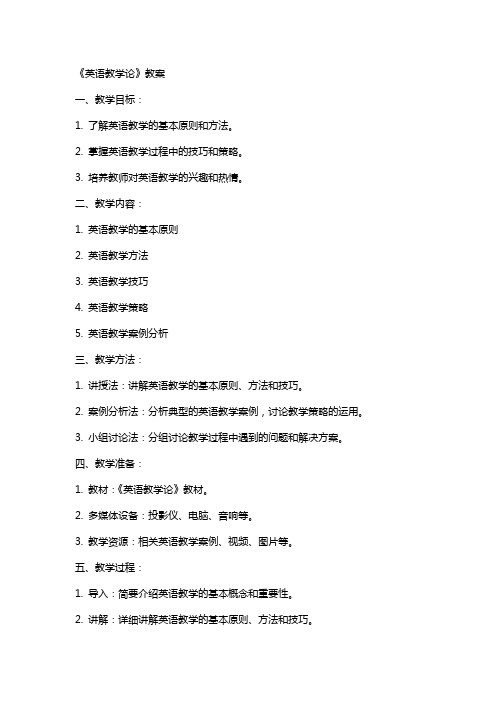
《英语教学论》教案一、教学目标:1. 了解英语教学的基本原则和方法。
2. 掌握英语教学过程中的技巧和策略。
3. 培养教师对英语教学的兴趣和热情。
二、教学内容:1. 英语教学的基本原则2. 英语教学方法3. 英语教学技巧4. 英语教学策略5. 英语教学案例分析三、教学方法:1. 讲授法:讲解英语教学的基本原则、方法和技巧。
2. 案例分析法:分析典型的英语教学案例,讨论教学策略的运用。
3. 小组讨论法:分组讨论教学过程中遇到的问题和解决方案。
四、教学准备:1. 教材:《英语教学论》教材。
2. 多媒体设备:投影仪、电脑、音响等。
3. 教学资源:相关英语教学案例、视频、图片等。
五、教学过程:1. 导入:简要介绍英语教学的基本概念和重要性。
2. 讲解:详细讲解英语教学的基本原则、方法和技巧。
3. 案例分析:分析典型的英语教学案例,引导学生讨论教学策略的运用。
4. 小组讨论:分组讨论教学过程中遇到的问题和解决方案。
5. 总结:总结本节课的重点内容,布置课后作业。
六、教学评估:1. 课堂参与度:观察学生在课堂讨论和小组活动中的参与情况。
3. 小组讨论报告:评估学生在小组讨论中的表现和提出的解决方案。
七、教学拓展:1. 组织一次英语教学模拟课堂,让学生亲身体验教学过程。
2. 邀请英语教学专家进行讲座,分享教学经验和心得。
3. 组织学生参观英语教学机构,了解实际教学环境和需求。
八、教学反馈:1. 收集学生对教学内容和教学方法的反馈意见。
2. 根据学生反馈调整教学计划和教学方法。
3. 定期与学生沟通,了解他们的学习进展和需求。
九、教学改进:1. 根据教学评估结果,对教学方法和策略进行调整。
2. 关注学生的学习困难,提供针对性的辅导和支持。
3. 不断更新教学资源,增加教学案例和实际教学经验分享。
十、教学总结:1. 总结整个学期的教学内容和成果。
2. 鼓励学生分享他们的学习心得和收获。
希望对您有所帮助!如有需要,请随时提问。
英语教学论

外国语学院成人教育英语教育特色专业建设教学指导书《英语教学论》课程教学指导书吴曼蕾编写淮阴师范学院外国语学院二0一二年九月课程介绍《英语教学论》是普通高等学校英语(教师教育)本科专业的一门必修课,具有基础理论和基本技能实践相结合的学科特点。
该课程传授英语教育教学基本理论和知识,训练英语教学基本技能,具备较高的英语教育理论素养和较强的教学工作能力,能适应21世纪教育改革发展和新一轮教学改革需要的、具有创新精神及创新能力的中小学英语教师。
学生通过课程学习,能初步形成对语言及语言学习本质的正确认识和科学的外语教学观,认识本课程中英语教学的性质及其发展演变过程,了解二十一世纪的英语课程改革,把握英语课程的理念,理解英语课程的性质及目标,掌握英语课程教学设计的基本原理,对语音、词汇、语法教学,听说读写教学和综合性学习教学等问题有所把握。
本课程还注重英语教学实践能力的培养,指导并帮助学生把教学理论与实践相结合,引导学生树立对外语教学作为一种职业和一门科学的正确态度,为其今后成为具备一定教学实践能力的合格中小学英语教师做好准备。
《英语教学论》是研究英语教学规律的一门科学。
“教学论”的含意是指一种理论“法则”(law) 或“体系”(system),而不是狭义的单纯指具体的教学方式方法。
英语教学论研究英语教学的全过程及其规律。
教学内容主要包括:1、教学理论;2、基本教学理论的教学方法和技巧;3、英语课外活动、教学手段和测试手段。
本自学指导书主要是依据高等教育出版社出版的由王蔷主编的《英语教学法教程》(第二版)而写的,并在此基础上对内容进行了必要的增减。
目的是为了进一步便于学生们自学及教师们安排好各个;教学环节和面授内容。
该门课程的学时分配如下:总学时72,讲授20学时,自学52学时。
面授安排在第三学年进行。
这门课程是考试课程。
对教师布置的作业,学生应独立完成并按时交给教师批改。
由于本人水平有限,书中有不当之处,望使用该书的教师和同学们批评指正。
英语课程与教学论第二版课程内容
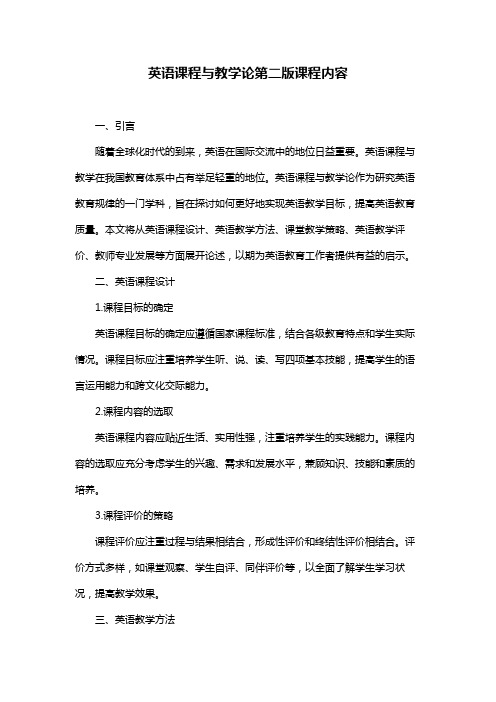
英语课程与教学论第二版课程内容一、引言随着全球化时代的到来,英语在国际交流中的地位日益重要。
英语课程与教学在我国教育体系中占有举足轻重的地位。
英语课程与教学论作为研究英语教育规律的一门学科,旨在探讨如何更好地实现英语教学目标,提高英语教育质量。
本文将从英语课程设计、英语教学方法、课堂教学策略、英语教学评价、教师专业发展等方面展开论述,以期为英语教育工作者提供有益的启示。
二、英语课程设计1.课程目标的确定英语课程目标的确定应遵循国家课程标准,结合各级教育特点和学生实际情况。
课程目标应注重培养学生听、说、读、写四项基本技能,提高学生的语言运用能力和跨文化交际能力。
2.课程内容的选取英语课程内容应贴近生活、实用性强,注重培养学生的实践能力。
课程内容的选取应充分考虑学生的兴趣、需求和发展水平,兼顾知识、技能和素质的培养。
3.课程评价的策略课程评价应注重过程与结果相结合,形成性评价和终结性评价相结合。
评价方式多样,如课堂观察、学生自评、同伴评价等,以全面了解学生学习状况,提高教学效果。
三、英语教学方法1.口语教学法口语教学法注重学生在实际语境中进行语言交流,提高学生的口头表达能力。
教师可通过组织课堂讨论、角色扮演等活动,让学生在实践中掌握英语口语。
2.听力教学法听力教学法着重培养学生的英语听力技能。
教师可利用多媒体教学手段,如录音、视频等,为学生提供丰富的听力素材,提高学生的听力水平。
3.阅读教学法阅读教学法旨在提高学生的英语阅读能力。
教师可通过讲解阅读策略、组织阅读活动等方式,帮助学生掌握阅读技巧,培养良好的阅读习惯。
4.写作教学法写作教学法关注学生书面表达能力的培养。
教师可通过指导写作技巧、提供写作示范等途径,引导学生完成不同类型的写作任务,提高写作质量。
四、课堂教学策略1.任务型教学法任务型教学法以任务为载体,让学生在完成任务的过程中学习英语。
教师设计具有挑战性、趣味性的任务,激发学生学习兴趣,提高课堂参与度。
英语教学理论课程教学大纲
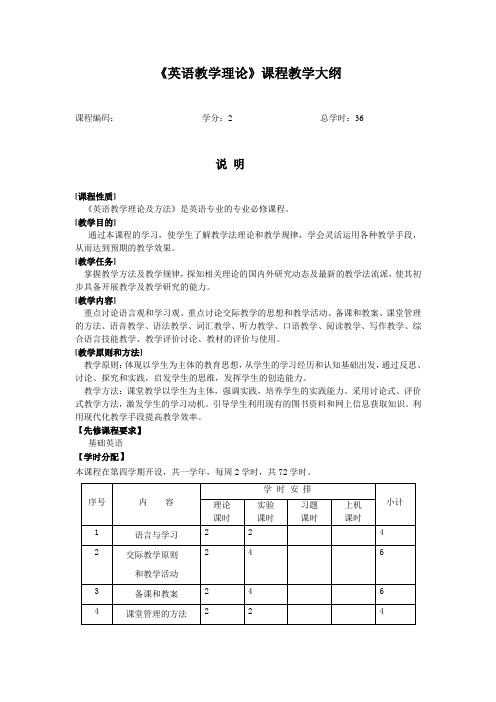
《英语教学理论》课程教学大纲课程编码:学分:2 总学时:36说明[课程性质]《英语教学理论及方法》是英语专业的专业必修课程。
[教学目的]通过本课程的学习,使学生了解教学法理论和教学规律,学会灵活运用各种教学手段,从而达到预期的教学效果。
[教学任务]掌握教学方法及教学规律,探知相关理论的国内外研究动态及最新的教学法流派,使其初步具备开展教学及教学研究的能力。
[教学内容]重点讨论语言观和学习观、重点讨论交际教学的思想和教学活动、备课和教案、课堂管理的方法、语音教学、语法教学、词汇教学、听力教学、口语教学、阅读教学、写作教学、综合语言技能教学、教学评价讨论、教材的评价与使用。
[教学原则和方法]教学原则:体现以学生为主体的教育思想,从学生的学习经历和认知基础出发,通过反思、讨论、探究和实践,启发学生的思维,发挥学生的创造能力。
教学方法:课堂教学以学生为主体,强调实践,培养学生的实践能力。
采用讨论式、评价式教学方法,激发学生的学习动机。
引导学生利用现有的图书资料和网上信息获取知识。
利用现代化教学手段提高教学效率。
【先修课程要求】基础英语【学时分配】本课程在第四学期开设,共一学年,每周2学时,共72学时。
[课程教材及必要参考书]教材:王蔷《英语教学法教程》高等教育出版社2000年。
参考书:English Language Teaching Methodology 外语教学与研究出版社2001年。
Aspects of Language Teaching 上海外语教育出版社2000年。
大纲内容第一部分语言与学习[教学目的和要求]教学目的:了解语言教学的相关问题教学要求:掌握语言教学的基本原理[内容提要]第一节一、学习语言的目的二、语言观三、语言学习观[教学重点与难点问题]教学重点:语言观、语言学习观教学难点:语言学习观[复习思考题]1.How can one become a good language teacher?2.What are the qualities of a good language teacher?第二部分交际教学原则和教学活动[教学目的和要求]教学目的:交际教学法在教学中的实践教学要求:掌握交际教学法的教学方法[内容提要]第一节一、语言的实际使用和传统教学法二、语言能力的培养三、语言技能的形成四、交际教学活动[教学重点与难点问题]教学重点:语言的实际使用和传统教学法、语言能力的培养教学难点:语言技能的形成[复习思考题]1. How to conduct communicative activities in the English classroom?2. What are the relationship between language use in real life and traditional pedagogy?第三部分教案[教学目的和要求]教学目的:学习教案的写作方法教学要求:掌握教案的写作方法[内容提要]第一节一、教案的必要性二、写好教案的原则三、宏观教案和微观教案四、教案的组成[教学重点与难点问题]教学重点:写好教案的原则、教案的组成教学难点:宏观教案和微观教案[复习思考题]1. Which planning do we often make, macro planning or micro planning? Why?2. What are the components of a lesson plan?第四部分课堂管理[教学目的和要求]教学目的:学习有效的课堂管理方法教学要求:掌握有效的课堂管理方法[内容提要]第一节一、教师的作用二、学生分组三、课堂纪律[教学重点与难点问题]教学重点:教师的作用教学难点:课堂纪律[复习思考题]1.How can we maintain discipline in the classroom?2. What do you think the teacher does when he/she is a controller, an assessor, an organizer, a prompter, a participant and a resource-provider respectively?第五部分语音教学[教学目的和要求]教学目的:了解语音教学的教学过程教学要求:掌握语音教学的教学方法[内容提要]第一节一、语音的作用二、语音教学的目标三、语音的组成四、语音练习[教学重点与难点问题]教学重点:语音的组成、语音练习教学难点:语音练习、语调和重音[复习思考题]1.How can teachers help the students to practice pronunciation?2.If we should not require native-like pronunciation, What should be our realistic goals?第六部分语法教学[教学目的和要求]教学目的:了解语法教学的教学过程教学要求:掌握语法教学的教学方法[内容提要]第一节一、英语教学中语法的作用二、语法演练方法三、语法练习[教学重点与难点问题]教学重点:语法演练方法、语法练习教学难点:语法演练方法[复习思考题]1.What do you think about the belief that teaching grammar is less important for children than for adults?2. Which method do you like better, deductive method or inductive method?第七部分词汇教学[教学目的和要求]教学目的:了解词汇教学的教学过程教学要求:掌握词汇教学的教学方法[内容提要]第一节一、词汇和词汇积累二、新词的使用三、词汇的巩固四、词汇积累策略[教学重点与难点问题]教学重点:词汇和词汇积累、词汇的巩固教学难点:词汇的巩固[复习思考题]1.Can words be taught and learned most effectively in groups of words which are related to each other in meaning?2.How to present the word “grumble”?第八部分听力教学[教学目的和要求]教学目的:了解听力技能的教学过程教学要求:掌握听力技能的教学方法[内容提要]第一节一、听力较难得原因二、听力训练过程的特点三、听力教学的原则[教学重点与难点问题]教学重点:听力训练过程的特点、听力教学的原则教学难点:听力教学的原则[复习思考题]1.What are the common activities in teaching listening?2.What are the principles of teaching listening?第九部分口语教学[教学目的和要求]教学目的:了解口语技能的训练过程教学要求:掌握口语技能的教学方法[内容提要]第一节一、口语的特点二、口语练习的设置三、分组练习模式[教学重点与难点问题]教学重点:口语的特点、口语练习的设置教学难点:口语练习的设置[复习思考题]1. 1.What are the common activities in teaching speaking?2. What are the principles of teaching speaking?第十部分阅读教学[教学目的和要求]教学目的:了解阅读技能的教学过程教学要求:掌握阅读技能的教学方法[内容提要]第一节一、如何阅读二、如何选读三、阅读理解的技巧四、阅读教学的原则[教学重点与难点问题]教学重点:阅读理解的技巧、阅读教学的原则教学难点:阅读理解的技巧[复习思考题]1. 1.What are the common activities in teaching reading?2.What are the principles of teaching reading?第十一部分写作教学[教学目的和要求]教学目的:了解写作技能的教学过程教学要求:掌握写作技能的教学方法[内容提要]第一节一、写作的实际特点二、交际写作法三、写作的难点[教学重点与难点问题]教学重点:交际写作法、写作的难点教学难点:交际写作法[复习思考题]1. What are the common activities in teaching writing?2. What are the principles of teaching writing?第十二部分综合语言技能教学[教学目的和要求]教学目的:听、说、读、写四种技能的综合运用教学要求:掌握听、说、读、写四种技能的综合运用方法[内容提要]第一节一、四项基本技能的综合二、如何综合四项基本技能三、综合四项基本技能的限制[教学重点与难点问题]教学重点:四项基本技能的综合、如何综合四项基本技能?教学难点:如何综合四项基本技能[复习思考题]1.How can we integrate the four skills?2. What are the limitations of integrating the four skills?第十三部分教学评价[教学目的和要求]教学目的:语言教学中如何进行评估。
高职《英语教学论》课程标准

高职《英语教学论》课程标准一、课程说明《英语教学论》课程标准课程编码:承担单位:制定:制定日期:审核:审核日期:批准:批准日期:1、课程性质:本门课程是职业学院英语教育专业的一门专业必修课。
2、课程任务:主要针对小学英语教学岗位开设,主要任务是培养学生在小学英语教学岗位的教育教学能力,要求学生掌握英语语言教学中使用的方法和技巧,并了解其理论依据;提高学生对语言教学原则、教学规律的理解,并且引导学生将这些原则应用于教学中,使其能够胜任未来的小学英语教学工作。
3、课程衔接:在课程设置上,前导课程有基础英语、教育学、心理学,后续课程有英语教学实训、教学实习。
二、学习目标通过本门课程的学习,学生应熟练掌握英语教学的基本理论和基本方法,并能针对小学英语课堂教学实际,将英语教学理论与小学教学实践相结合,从而培养学生对小学英语教学实践的认识、思考、判断、分析、设计和研究能力。
具体目标分述如下:1、知识和技能目标:(1)了解语言与语言学习的基本概念;(2)理解英语教学的主要理论;(3)掌握英语教学设计的一般方法;(4)掌握英语课堂教学过程与教学效果的评价方法。
2、能力目标:(1)能够正确描述教学目标、重点与难点,分析教学内容,并能根据学生特点和教学条件设计有效的英语教学活动;(2)积极开展英语课堂教学微技能整合,探索英语教学的有效途径;(3)能利用所学技能进行教学设计;(4)能利用所学方法与技巧进行英语教学演示。
3、思想政治素养目标:(1)能够认识到教学能力是英语教师专业素质的必要组成部分;(2)能够认识到科学教学方法的有效应用对于优化教学过程,培养创新型人才的重要作用;(3)具有不断学习新知识和探索新理论以完善自身素质结构的意识与态度。
三、课程设计本课程以职业能力目标为载体,根据小学英语教学岗位工作任务要求,确定学习目标及学习任务内容;本课程采取行动导向项目教学教学模式,以学生为主体、以培养学生课堂教学能力为导向组织教学考核。
大三英语课程与教学论
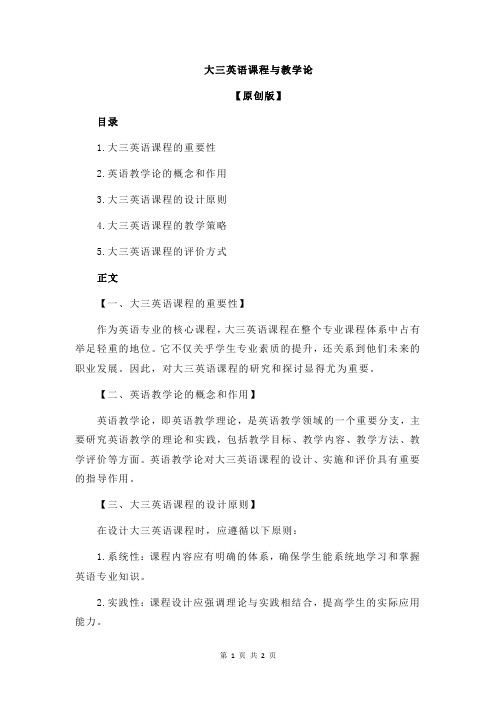
大三英语课程与教学论【原创版】目录1.大三英语课程的重要性2.英语教学论的概念和作用3.大三英语课程的设计原则4.大三英语课程的教学策略5.大三英语课程的评价方式正文【一、大三英语课程的重要性】作为英语专业的核心课程,大三英语课程在整个专业课程体系中占有举足轻重的地位。
它不仅关乎学生专业素质的提升,还关系到他们未来的职业发展。
因此,对大三英语课程的研究和探讨显得尤为重要。
【二、英语教学论的概念和作用】英语教学论,即英语教学理论,是英语教学领域的一个重要分支,主要研究英语教学的理论和实践,包括教学目标、教学内容、教学方法、教学评价等方面。
英语教学论对大三英语课程的设计、实施和评价具有重要的指导作用。
【三、大三英语课程的设计原则】在设计大三英语课程时,应遵循以下原则:1.系统性:课程内容应有明确的体系,确保学生能系统地学习和掌握英语专业知识。
2.实践性:课程设计应强调理论与实践相结合,提高学生的实际应用能力。
3.针对性:针对学生的实际情况和需求进行课程设计,满足他们的学习需求。
4.前瞻性:课程内容应具有一定的前瞻性,以适应社会发展的需要。
【四、大三英语课程的教学策略】在实施大三英语课程时,可采用以下教学策略:1.任务型教学法:通过设置具体的任务,引导学生主动参与学习,提高他们的学习兴趣和积极性。
2.合作学习:鼓励学生进行小组合作学习,培养他们的团队协作和沟通能力。
3.自主学习:培养学生的自主学习能力,引导他们通过多种途径和方法进行学习。
【五、大三英语课程的评价方式】在评价大三英语课程时,可采用多元化的评价方式,如:1.考试成绩:通过期中、期末等形式的考试,测试学生的专业知识掌握程度。
2.课堂表现:包括出勤率、课堂互动、课堂报告等方面。
3.实践作业:如课程论文、翻译作业等,检验学生的实际应用能力。
《英语教学论》课程教学大纲
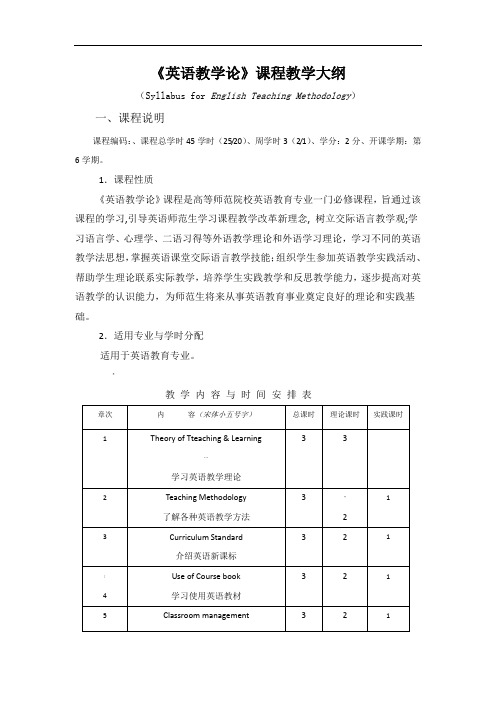
《英语教学论》课程教学大纲(Syllabus for English Teaching Methodology)一、课程说明课程编码:、课程总学时45学时(25/20)、周学时3(2/1)、学分:2分、开课学期:第6学期。
1.课程性质《英语教学论》课程是高等师范院校英语教育专业一门必修课程,旨通过该课程的学习,引导英语师范生学习课程教学改革新理念, 树立交际语言教学观;学习语言学、心理学、二语习得等外语教学理论和外语学习理论,学习不同的英语教学法思想,掌握英语课堂交际语言教学技能;组织学生参加英语教学实践活动、帮助学生理论联系实际教学,培养学生实践教学和反思教学能力,逐步提高对英语教学的认识能力,为师范生将来从事英语教育事业奠定良好的理论和实践基础。
2.适用专业与学时分配适用于英语教育专业。
*教学内容与时间安排表3.课程教学目的与要求:I.教学目的:通过《英语教学论》课程的学习,帮助英语师范生具有新课程教学改革的理念和职业规范与师德,掌握一定的外语教学理论和外语学习理论,了解交互性语言教学的课堂教学理论基础,培养英语教学实践经历和反思教学的的能力,促进师范生在学术上的可持续发展的基本素质。
II.教学要求:教师通过多媒体讲授英语教学理论、教学流派、课程标准和教学原则等知识后,组织师范生进行小组为单位的教学内容演示等教学实践活动,提高师范生对英语教学本质的认识,使他们一定的理论高度,具备反思教学的可持续发展的能力,逐步完善自己的英语教学能力。
4.本门课程与其它课程关系本课程是在第6学期开设的专业基础必修课,学生已经学习了英语专业的一些基础课程以及一些相关的通识课之后才开设,本门课程的开设对巩固和提高英语教师专业学生的专业素质会起到积极作用。
它既能够优化教育理论课程,如心理学、教育学等,同时也能够检验学生对所学英语专业知识的把握程度及综合运用英语语言的能力。
5.推荐教材及参考书推荐教材:Davies, Eric Pearse Success in English Teaching Shanghai Foreign Language Education Press, 20052.王蔷:《英语教学法教程》,高等教育出版社,2000年。
《英语课程教学论》教学大纲
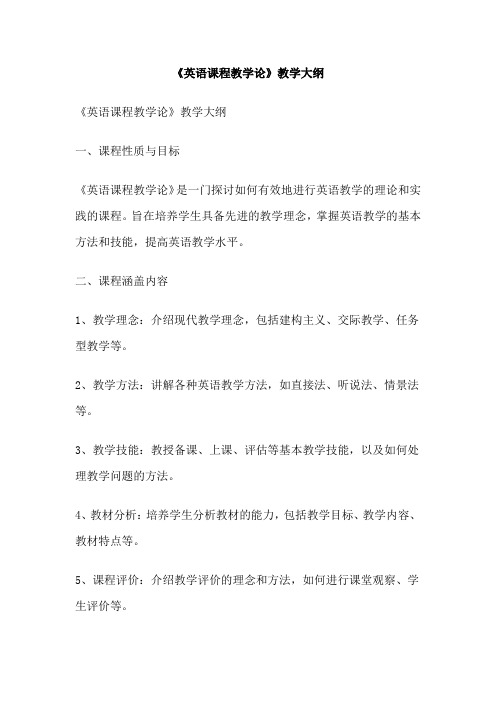
《英语课程教学论》教学大纲《英语课程教学论》教学大纲一、课程性质与目标《英语课程教学论》是一门探讨如何有效地进行英语教学的理论和实践的课程。
旨在培养学生具备先进的教学理念,掌握英语教学的基本方法和技能,提高英语教学水平。
二、课程涵盖内容1、教学理念:介绍现代教学理念,包括建构主义、交际教学、任务型教学等。
2、教学方法:讲解各种英语教学方法,如直接法、听说法、情景法等。
3、教学技能:教授备课、上课、评估等基本教学技能,以及如何处理教学问题的方法。
4、教材分析:培养学生分析教材的能力,包括教学目标、教学内容、教材特点等。
5、课程评价:介绍教学评价的理念和方法,如何进行课堂观察、学生评价等。
三、课程教学方式本课程采用理论和实践相结合的方式进行教学,包括以下几种形式:1、课堂讲解:对理论知识进行系统讲解,帮助学生深入理解教学理念和方法。
2、案例分析:通过分析真实的英语教学案例,培养学生分析问题和解决问题的能力。
3、小组讨论:鼓励学生分组讨论,共同探讨英语教学中的实际问题,培养合作精神。
4、教学实践:安排学生进行教学实践,提高教学技能和解决实际教学问题的能力。
四、课程评估方式本课程的评估方式包括以下几种:1、课堂表现:根据学生在课堂上的表现,包括提问、回答问题、参与讨论等,给予平时成绩。
2、作业:布置相关作业,包括论文、教案、教学反思等,以检查学生对课程内容的掌握情况。
3、期末考试:通过书面考试检查学生对课程理论和实践知识的掌握程度。
通过以上课程内容和评估方式,旨在使学生全面了解英语教学的理论和实践,提高英语教学水平,为未来的教学工作打下坚实的基础。
英语课程与教学论教学大纲
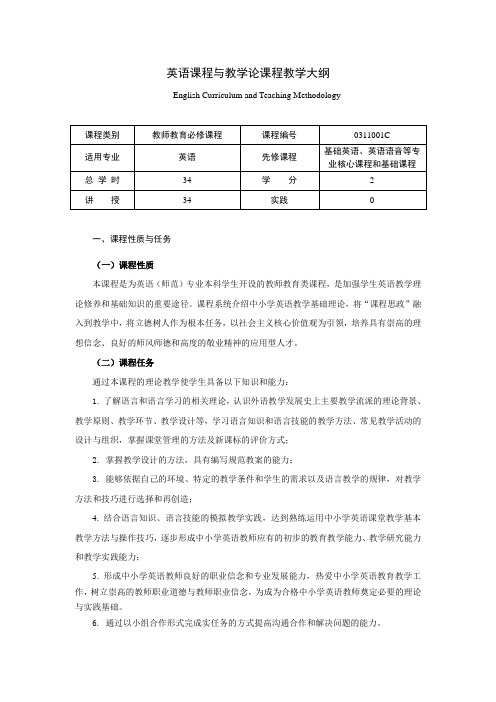
英语课程与教学论课程教学大纲English Curriculum and Teaching Methodology一、课程性质与任务(一)课程性质本课程是为英语(师范)专业本科学生开设的教师教育类课程,是加强学生英语教学理论修养和基础知识的重要途径。
课程系统介绍中小学英语教学基础理论,将“课程思政”融入到教学中,将立德树人作为根本任务,以社会主义核心价值观为引领,培养具有崇高的理想信念、良好的师风师德和高度的敬业精神的应用型人才。
(二)课程任务通过本课程的理论教学使学生具备以下知识和能力:1.了解语言和语言学习的相关理论,认识外语教学发展史上主要教学流派的理论背景、教学原则、教学环节、教学设计等,学习语言知识和语言技能的教学方法、常见教学活动的设计与组织,掌握课堂管理的方法及新课标的评价方式;2. 掌握教学设计的方法,具有编写规范教案的能力;3. 能够依据自己的环境、特定的教学条件和学生的需求以及语言教学的规律,对教学方法和技巧进行选择和再创造;4. 结合语言知识、语言技能的模拟教学实践,达到熟练运用中小学英语课堂教学基本教学方法与操作技巧,逐步形成中小学英语教师应有的初步的教育教学能力、教学研究能力和教学实践能力;5. 形成中小学英语教师良好的职业信念和专业发展能力,热爱中小学英语教育教学工作,树立崇高的教师职业道德与教师职业信念,为成为合格中小学英语教师奠定必要的理论与实践基础。
6. 通过以小组合作形式完成实任务的方式提高沟通合作和解决问题的能力。
二、教学活动目标(一)课程目标通过本课程的理论教学,使学生具备下列能力:课程目标1:能够运用外语教学基本理论和外语学习理论,根据需要运用恰当的教学方法和技巧,具有编写教案、课堂管理和教学评价的能力。
(支撑毕业要求指标点1-4)课程目标2:未来能够成为具有良好的师风师德,较强的法制观念和诚信意识的合格的教师。
(支撑毕业要求指标点2-2)课程目标3:能够熟练准确地运用英语语言进行教学,发出课堂指令,恰当地对学生予以评价。
《英语教学论》教案

《英语教学论》教案一、前言1. 教学目标:通过本章的学习,使学生了解英语教学的基本概念、教学法及其发展历程,为后续教学实践打下理论基础。
2. 教学内容:英语教学的基本概念、教学法及其发展历程。
3. 教学方法:讲授、讨论、案例分析。
4. 教学重点:英语教学的基本概念、教学法及其在实际教学中的应用。
5. 教学难点:教学法的内涵及其在实际教学中的运用。
二、英语教学的基本概念1. 教学目标:使学生掌握英语教学的基本概念,如教学目标、教学内容、教学过程等。
2. 教学内容:a. 教学目标的制定b. 教学内容的选取与组织c. 教学过程的设计与实施d. 教学评价的方法与原则3. 教学方法:讲授、讨论。
4. 教学重点:教学目标、教学内容、教学过程、教学评价的概念及其相互关系。
5. 教学难点:教学目标、教学内容、教学过程、教学评价在实际教学中的运用。
三、英语教学法及其发展历程1. 教学目标:使学生了解英语教学法的基本类型及其发展历程,掌握各类教学法的特点与应用。
a. 直接法b. 间接法c. 交际法d. 任务型教学法e. 信息技术辅助教学法f. 教学法的发展历程3. 教学方法:讲授、讨论、案例分析。
4. 教学重点:各类教学法的特点与应用。
5. 教学难点:各类教学法在实际教学中的整合与运用。
四、教学计划与教学大纲1. 教学目标:使学生掌握教学计划与教学大纲的编制方法,能够根据教学目标编写教学计划与教学大纲。
2. 教学内容:a. 教学计划的编制b. 教学大纲的编制c. 教学计划与教学大纲的实施与调整3. 教学方法:讲授、讨论、案例分析。
4. 教学重点:教学计划与教学大纲的编制方法及其在实际教学中的应用。
5. 教学难点:教学计划与教学大纲在实际教学中的实施与调整。
五、教学评价1. 教学目标:使学生了解教学评价的基本概念、方法及其在英语教学中的应用。
a. 教学评价的基本概念b. 教学评价的方法c. 教学评价的原则d. 教学评价在英语教学中的应用3. 教学方法:讲授、讨论、案例分析。
《英语教学论》教案
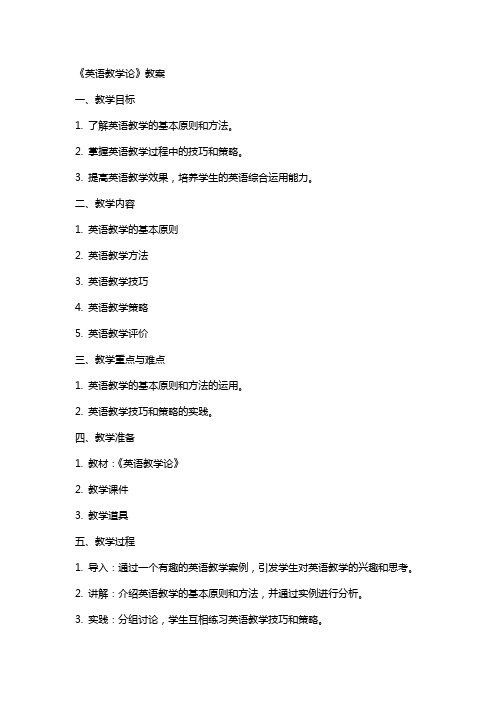
《英语教学论》教案一、教学目标1. 了解英语教学的基本原则和方法。
2. 掌握英语教学过程中的技巧和策略。
3. 提高英语教学效果,培养学生的英语综合运用能力。
二、教学内容1. 英语教学的基本原则2. 英语教学方法3. 英语教学技巧4. 英语教学策略5. 英语教学评价三、教学重点与难点1. 英语教学的基本原则和方法的运用。
2. 英语教学技巧和策略的实践。
四、教学准备1. 教材:《英语教学论》2. 教学课件3. 教学道具五、教学过程1. 导入:通过一个有趣的英语教学案例,引发学生对英语教学的兴趣和思考。
2. 讲解:介绍英语教学的基本原则和方法,并通过实例进行分析。
3. 实践:分组讨论,学生互相练习英语教学技巧和策略。
4. 展示:每组选出一名代表,进行英语教学演示。
5. 评价:教师对学生的英语教学进行评价和指导。
7. 作业:布置相关的英语教学练习题,让学生进行巩固。
六、教学方法与技巧1. 任务型教学法:通过完成实际任务,激发学生的学习兴趣和积极性。
2. 交际型教学法:注重学生之间的互动和交流,提高口语表达能力。
3. 情境教学法:创造真实的语言环境,提高学生的语言运用能力。
4. 游戏教学法:通过趣味游戏,增加学习的趣味性和互动性。
七、教学评价与反馈1. 形成性评价:关注学生的学习过程,及时给予指导和鼓励。
3. 自我评价:鼓励学生自我反思,提高自主学习能力。
4. 同伴评价:学生之间互相评价,促进互动和共同进步。
八、教学策略与技巧1. 启发式教学:引导学生主动思考和探索,提高学习兴趣。
2. 差异化教学:关注学生的个体差异,满足不同学生的学习需求。
3. 合作学习:鼓励学生合作完成任务,提高团队协作能力。
4. 信息技术辅助教学:利用多媒体和网络资源,丰富教学内容和形式。
九、教学案例分析2. 分析一个失败的英语教学案例,找出问题所在并提出改进措施。
2. 反思教学方法和策略的有效性,提出改进和优化建议。
3. 强调英语教学的实践性和持续性,鼓励学生在实践中不断探索和进步。
大三英语课程与教学论
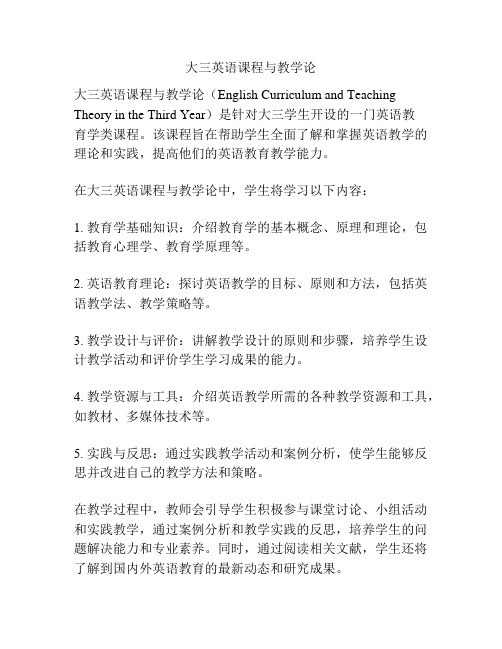
大三英语课程与教学论
大三英语课程与教学论(English Curriculum and Teaching Theory in the Third Year)是针对大三学生开设的一门英语教
育学类课程。
该课程旨在帮助学生全面了解和掌握英语教学的理论和实践,提高他们的英语教育教学能力。
在大三英语课程与教学论中,学生将学习以下内容:
1. 教育学基础知识:介绍教育学的基本概念、原理和理论,包括教育心理学、教育学原理等。
2. 英语教育理论:探讨英语教学的目标、原则和方法,包括英语教学法、教学策略等。
3. 教学设计与评价:讲解教学设计的原则和步骤,培养学生设计教学活动和评价学生学习成果的能力。
4. 教学资源与工具:介绍英语教学所需的各种教学资源和工具,如教材、多媒体技术等。
5. 实践与反思:通过实践教学活动和案例分析,使学生能够反思并改进自己的教学方法和策略。
在教学过程中,教师会引导学生积极参与课堂讨论、小组活动和实践教学,通过案例分析和教学实践的反思,培养学生的问题解决能力和专业素养。
同时,通过阅读相关文献,学生还将了解到国内外英语教育的最新动态和研究成果。
大三英语课程与教学论为学生打下坚实的英语教育理论基础,提高他们的英语教学能力和专业素养,为以后从事英语教育相关工作打下扎实的基础。
《英语课程教学论》教学大纲

《英语课程教学论》一、课程说明1.课程代码:1070050112.课程中文名称:中学英语教学法3.课程英文名称:A Course in English Language Teaching4.课程总学时数:455.课程学分数:36.授课对象:英语专业三年级学生7.本课程的性质、地位和作用本课程是为英语教育专业本科生开设的教育课程,教学方式为课堂教学(基于案例的分析、讨论、练习),结合教育见习实践,为英语专业师范生毕业后从事英语教师职业做好理论与技能的准备。
中学英语教学法课程旨在为学生提供英语教育学的发展历史以及国内外相关理论与研究。
通过对英语教学法各流派发展过程及其核心理论的分析,培养学生批判性地对待各种教学法理论和模式,科学合理地折衷选用适合教学对象与教学目标的教学法。
同时结合英语教学改革的前沿信息,解读《国家英语课程标准》的教学理念、包括教学目标、教学方法、教材使用以及教学评估等方面。
在教学中尽可能多地结合实际教学案例,以学生为中心,以小组为合作单位,进行模拟实践式、讨论式、探究式教学。
教学中启发学生反思自身的英语学习经历,结合各类英语优质课堂实录的观摩点评分析,通过小组协作探究讨论,逐步形成和丰富学生自己的教学理论。
此外为学生提供各类中学英语教研资源,如关于中学英语教学研究的参考书籍、期刊,Blackboard上的本课程教学网站的其他课程资源,使学生加深对英语学科教育的理解、思考及理论积累;同时也通过Blackboard为学生提供教学交流、反馈的平台。
并在此基础上,初步奠定学生的英语学科教育科研能力。
二、教学基本要求1.本课程的目的、任务通过本课程学习,学生将了解未来英语教师职业的要求,国内外英语教学法流派发展状况和国内英语教学改革前沿信息,认识交际语言教学法、任务型教学法等主流英语教学法的理论背景、教学原则、教学环节、教学设计等,结合英语新课程标准改革,探究适合实际教学对象与教学目标的教学模式。
《英语教学论》教案

《英语教学论》教案一、教学目标1. 了解英语教学的基本原则和方法。
2. 掌握英语教学设计的基本步骤。
3. 熟悉英语教学评价的标准和手段。
4. 提高英语教学实践能力。
二、教学内容1. 英语教学的基本原则2. 英语教学方法3. 英语教学设计4. 英语教学评价5. 英语教学实践三、教学方法1. 讲授法:讲解英语教学的基本原则、方法和评价手段。
2. 案例分析法:分析典型英语教学设计案例,讨论其优点和不足。
3. 小组讨论法:分组讨论英语教学实践中遇到的问题,分享经验。
4. 模拟教学法:进行模拟教学,提高学员的英语教学能力。
四、教学安排1. 第一课时:英语教学的基本原则2. 第二课时:英语教学方法3. 第三课时:英语教学设计4. 第四课时:英语教学评价5. 第五课时:英语教学实践五、教学评价1. 课堂参与度:评估学员在课堂讨论、提问和分享经验方面的积极性。
2. 模拟教学效果:评估学员在模拟教学中的表现,包括教学内容、方法和组织能力。
3. 课后作业:评估学员对教学内容的掌握程度,以及运用所学知识解决实际问题的能力。
4. 期末考试:全面测试学员对英语教学理论和实践的掌握程度。
六、教学资源1. 教材:《英语教学论》教材,用于讲解基本理论和知识点。
2. 案例库:收集各类英语教学设计案例,用于分析和讨论。
3. 模拟教学材料:提供模拟教学所需的教材、课件等资源。
4. 视听资料:播放优秀英语教学视频,供学员学习借鉴。
5. 在线资源:推荐相关英语教学网站和论坛,便于学员课后学习和交流。
七、教学过程1. 导入:每节课开始时,用几分钟时间引导学员回顾上节课的内容,为新课的学习做好铺垫。
2. 讲解:详细讲解本节课的教学内容,通过案例分析、互动讨论等方式,帮助学员理解和掌握知识点。
3. 实践:安排模拟教学环节,让学员亲自动手实践,提高教学能力。
4. 总结:每节课结束前,对所学内容进行总结,强调重点和难点。
5. 作业布置:布置课后作业,巩固所学知识,培养学员独立思考和解决问题的能力。
《英语教学论》教案

《英语教学论》教案第一章:英语教学论概述1.1 教学论的概念与发展1.2 英语教学论的重要性1.3 英语教学论的研究对象与方法1.4 英语教学论的基本原则与理念第二章:英语教学目标与标准2.1 英语教学目标的制定2.2 英语教学标准的设计2.3 英语教学目标与标准的实施与评估2.4 英语教学目标与标准的调整与更新第三章:英语教学方法与策略3.1 英语教学方法的选择与应用3.2 英语教学策略的制定与实施3.3 英语教学活动设计与组织3.4 英语教学评价与反馈第四章:英语教学资源与材料4.1 英语教学资源的分类与利用4.2 英语教学材料的筛选与评估4.3 英语教学资源的整合与创新4.4 英语教学材料的制作与使用第五章:英语教师专业发展5.1 英语教师的角色与职责5.2 英语教师的专业素养与能力5.3 英语教师培训与进修5.4 英语教师评价与激励机制第六章:英语教学理论与模型6.1 交际语言教学理论6.2 任务型语言教学理论6.3 全身反应法与沉默法6.4 语言学习假设与教学实践第七章:英语课程设计与规划7.1 英语课程目标的设计7.2 英语课程内容的选择与组织7.3 英语课程计划的制定与实施7.4 英语课程的评价与调整第八章:英语教学技巧与艺术8.1 语音教学技巧8.2 词汇教学技巧8.3 语法教学技巧8.4 口语与听力教学技巧第九章:英语教学与文化因素9.1 语言与文化关系探讨9.2 英语教学中的文化导入9.3 跨文化交流能力培养9.4 文化差异对英语教学的影响第十章:英语教学研究与反思10.1 英语教学研究方法与步骤10.2 英语教学研究案例分析10.3 英语教学反思与自我评估10.4 英语教学研究与反思的应用重点和难点解析一、英语教学论概述难点解析:理解英语教学论的定义及其在语言教学领域的作用,掌握英语教学论的历史发展脉络。
二、英语教学目标与标准难点解析:如何确立具体、可操作的英语教学目标,以及如何根据教学目标设计相应的教学标准。
英语教学论教程 王蔷ppt课件
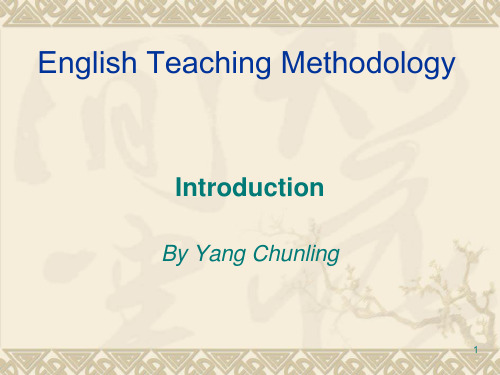
15
E-mail:chunlingyang2008@
Goodbye!
16
7
II. How to be a good English teacher?
❖ Not just a good command of foreign language, there are a variety of elements that contributes to the qualities of a good language teacher. They are: ethic devotion, professional qualities and personal styles. ( Parrot, 1993)
writing ❖ 4. Classroom English, teaching manners and
comments on class ❖ 5. Games, blackboard-design for English
teaching
13
Ⅴ. How to present this course.
12
IV. Topics for discussion:
❖ 1. Writing a teaching plan and talking about a class.
❖ 2. Teaching pronunciation, vocabulary, grammar. ❖ 3. Teaching listening, speaking, reading and
Confidence Motivation
- 1、下载文档前请自行甄别文档内容的完整性,平台不提供额外的编辑、内容补充、找答案等附加服务。
- 2、"仅部分预览"的文档,不可在线预览部分如存在完整性等问题,可反馈申请退款(可完整预览的文档不适用该条件!)。
- 3、如文档侵犯您的权益,请联系客服反馈,我们会尽快为您处理(人工客服工作时间:9:00-18:30)。
(一)《英语教学论》课程一、单项选择题Section I: Basic Theories and PrinciplesQuestions 1—10 are based on this part.Directions: Choose the best answer for the following questions and write your answers in the brackets.1. Which is true of the Natural Order of language acquisition? ()A. The Natural Order, consists of Listening to a great deal of meaningful language input, then Speaking, then Reading to a great deal of meaningful input, and finally Writing.B. The Natural Order, consists of Speaking to a great deal of meaningful language input, then Listening, then Reading to a great deal of meaningful input, and finally Writing.C. The Natural Order, consists of Listening to a great deal of meaningful language input, then Speaking, then Writing to a great deal of meaningful input, and finally Reading.D. The Natural Order, consists of Reading to a great deal of meaningful language input, then Speaking, then Listening to a great deal of meaningful input, and finally Writing.2. Which is true of authenticity? ()A. Language is simplified in some way for the convenience of learners of the language.B. An authentic text is one that has been written specially for language students.C. Authenticity in the language classroom includes the use of authentic materials, designing authentic classroom activities, and the teacher speaking authentically to the students.D. It is not close to the sort of thing one would do in real life.3. Reading is ()A. Reading is recognizing the written words in a text.B. Reading is the ability to articulate the words and pronounce them correctly.C. Reading is an active process. It constantly involves guessing, predicting, checking and asking oneself questions.D. Reading is the ability to remember words only.4. Pre-listening activities may serve several purposes except ()A. they can help students establish listening expectations.B. students use the information or language they acquired to do something else.C. pre-listening activities can activate students’ prior knowledge about the topic.D. they can arouse studen ts’ interest in learning.5. In ______stage, students are given the opportunities to use the newly presented language items in a controlled framework. This may be done by drills, or by repeating parts of the dialogue presented in the first stage. This stage is intended to develop accuracy skills. ()A. practiceB. presentationC. productionD. preparation6. A child watches cartoon on TV. Please choose why people listen in this situation. ()A. to extract informationB. to maintain social relationsC. to be entertainedD. to study7. Which of the following belongs to live presentation?()A. Published cassettesB. Friend’s talkC. Video tapesD. Recorded pop songs8. Which word has a positive connotation?()A. arrogantB. confidentC. stubbornD. mean9. A lesson plan is NOT influenced by ()A. physical conditionB. human factorsC. syllabusD. stationery10. The procedure of designing free writing tasks does NOT include ()A. getting ideas on the topicsB. selecting one ideaC. expanding one ideaD. editing二、简答题Section II: Problem SolvingDIRECTIONS: Situations in classroom teaching are provided here. In each situation there are some problems. Firstly, identify the problems; secondly, provide your own solutions according to the communicative language teaching principles and explain in details.1. Some teachers pay particular attention to the comfort of the classroom, and the learning environment: the lights are soft, the chairs are comfortable, there is soothing music playing in the background, texts are read to the students gently by the teacher. Finally the texts are given to the students with a parallel translation in their mother tongue and they work through it asking the t eacher questions about things they don’t understand in it.What do you like about this method? Why do you think translations of the text are given? What have we gained from the Humanists in our approach to teaching a foreign language?2. Read the following listening text, and try to design five different post-listening activities for it. You also need to make a brief statement of the purpose of your activity.Kate is going to the supermarket to buy some food. First, she decides what she needs to buy at home. How much bread does she need? What kind of vegetables? Is there enough fruit? Next, Kate makes a shopping list. She is going to buy two chickens, some cabbages, four tomatoes and two loaves of bread. She is going to buy 3 bottles of milk and 12 eggs. But she’s afraid she hasn’t got enough money, so she’ll have to stop at the bank on her way to the supermarket.(From Senior English Text book, Listening Workbook, Book 2A, PEP)3. There are different styles of grammar teaching and each style of grammar teaching has its benefits and drawbacks. Could you think over inductive grammar teaching and try to fill in the following tables with as many comments as you can.Inductive Grammar TeachingBenefits Drawbacks三、案例题Section III: Mini-lesson Plan or Text AnalysisDIRECTIONS: Read the following text carefully and complete the teaching plan.The text is a dialogue for teaching speaking for primary students. Design activities for teaching speaking in context if necessary.Chen: Welcome to our school!This is t he teacher’s office.That is my classroom.Visitor A: How many students are there in your class?Chen: Forty-five.Visitor B: Do you have a library?Chen: Yes.Visitor A: Do you have lunch at school?Chen: Yes! The canteen is on the first floor.This way, please.Your lesson plan should include the following aspects:Lesson Plan:1) Name(s) of activity (ies)2)Objective(s) of the activity(ies)3) Type(s) of the activity (ies)4) Classroom organization of the activity (ies)5) Teacher’s role(s)6) Students’ role(s)7) Teacher working time8) Student working time9) Teaching aid(s)10) Predicated problem(s)11) Solution(s)12) Homework13) ProceduresA. PreB. WhileC. Post。
